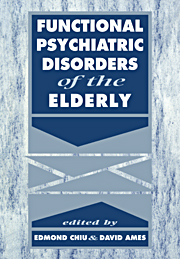Book contents
- Frontmatter
- Contents
- List of contributors
- Preface
- Introduction – A personal note
- Acknowledgement
- Part 1 Classification
- Part 2 General epidemiology
- Part 3 Neuroses
- 4 Panic disorders in the elderly
- 5 Obsessive–compulsive disorder in the elderly
- 6 Generalized anxiety and phobic disorders
- Part 4 Affective disorders
- Part 5 Psychosexual disorders
- Part 6 Substance use and abuse
- Part 7 Schizophrenia and related psychoses
- Part 8 Psychological, biological and medical issues
- Part 9 Treatment methods
- Part 10 Conclusion
- Index
4 - Panic disorders in the elderly
from Part 3 - Neuroses
Published online by Cambridge University Press: 13 November 2009
- Frontmatter
- Contents
- List of contributors
- Preface
- Introduction – A personal note
- Acknowledgement
- Part 1 Classification
- Part 2 General epidemiology
- Part 3 Neuroses
- 4 Panic disorders in the elderly
- 5 Obsessive–compulsive disorder in the elderly
- 6 Generalized anxiety and phobic disorders
- Part 4 Affective disorders
- Part 5 Psychosexual disorders
- Part 6 Substance use and abuse
- Part 7 Schizophrenia and related psychoses
- Part 8 Psychological, biological and medical issues
- Part 9 Treatment methods
- Part 10 Conclusion
- Index
Summary
Introduction
Anxiety disorders have been named and classified in various ways; often the diagnostic label chosen has reflected the patient's most prominent symptom. Examples include Da Costa's syndrome, neurasthenia, effort syndrome, soldier's heart, cardiac neurosis, and autonomic epilepsy (Judd & Burrows, 1985). Early descriptions of anxiety disorders did not differentiate ‘chronic nervousness’ from recurrent ‘anxiety attacks’ (Sheehan, 1982). Contemporary diagnostic systems (DSM-III-R, ICD-9) view anxiety disorders in dissimilar ways. In the ICD9 (World Health Organization, 1978) panic and generalized anxiety are grouped together as anxiety states. The DSM-III-R (American Psychiatric Association, 1987) contains separate categories of panic and generalized anxiety disorder.
Clinical features
Panic disorders are characterized by spontaneous attacks of anxiety which occur suddenly, without warning, for no apparent reason and not in response to a particular environmental stimulus. Commonly described symptoms include dyspnoea, palpitations, chest pain or discomfort, shortness of breath or smothering sensations, dizziness, vertigo or unsteady feelings, depersonalization and derealization, paresthesia, sweating, faintness, trembling or shaking. Prominent cognitive symptoms include fear of dying, fear of going crazy, and fear of losing control. A variety of additional symptoms may occur, at times influenced by coexisting medical illnesses. These include muscle aches and pains, urinary frequency and diarrhea, fear of urination and defecation, blurred vision, buzzing in the ears, nausea and vomiting. The DSM-III-R criteria for panic disorder are shown in Table 4.1.
Spontaneous attacks usually occur against a background of generalized anxiety.
- Type
- Chapter
- Information
- Functional Psychiatric Disorders of the Elderly , pp. 47 - 61Publisher: Cambridge University PressPrint publication year: 1994



